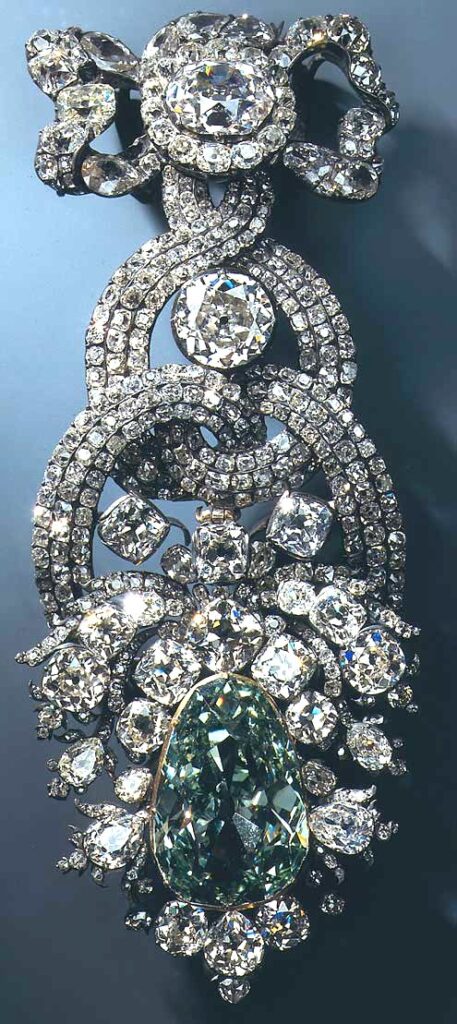
Labeled as the greatest example of a naturally green colored diamond, the Dresden Green survives today because of the preparedness of its former owners and a healthy combination of good timing and luck. It survived in a region subjected to numerous wars – especially two that threatened its very existence. Eventually, it was moved to a communist country where it languished for years behind the Iron Curtain. Yet, with all this adversity, the Dresden Green diamond managed to survive and as a result, is still enjoyed by those who come to observe its magnificence.
As strange as it may be, the impressive Dresden Green diamond had an inauspicious beginning. Research tells us it was initially offered for sale to two different monarchs. In a newspaper article dated October 1722, the story reports a London diamond dealer named Marcus Moses bringing the green diamond – valued at £10,000 – to the attention of King George (1714-1727). Four years later, the next mention of the Dresden Green diamond appears in a letter from Baron Gautier of Dresden to the Polish ambassador in London. The discussion revolves around the green diamond being offered for £30,000 to Frederick Augustus I (1694-1753), a noted collector who created the famous Green Vault at Dresden Castle for the storage of his jewelry collection. Amazingly, neither monarch seized the opportunity to purchase the stone!
That honor was left to Frederick Augustus II (1733-1763). Acquiring the stone from a Dutch merchant in 1741 at the Leipzig Fair, speculation put the price at 400,000 thaler. Frederick Augustus II had the diamond set in the Decoration of the Golden Fleece. Four years later the Dresden Green was remounted into a new Golden Fleece design so that it could be paired with another diamond, the Dresden White, a 49.71 carat cushion-shaped diamond. This setting was dismantled in 1768 by a jeweler named Diessbach, who in turn created a hat ornament combining the Dresden Green, two large colorless diamonds, and many smaller stones. This is the setting that the Dresden Green still appears in today. When not being worn, the ornament was – and is – stored in the Green Vault.
The first serious threat to the Dresden Green came with the outbreak of the Seven Years’ War in 1754. To insure its safety the diamond, along with the rest of Frederick Augustus II’s invaluable collection, was removed from the Green Vault and relocated to the Königstein fortress outside of Dresden. With the conclusion of the Seven Years’ War, the entire collection returned to the Green Vault, where it remained on display to the public until the third year of World War II.
With most of the European continent engulfed in war, the contents of the Green Vault were once again relocated to Königstein in 1942. Unknown at the time, this move turned out to be most advantageous in securing the stone’s survival, for in February of 1945 the city of Dresden became the victim of one of the most devastating air raids in the history of warfare. The infamous firebombing left much of the city totally destroyed. Fortunately for the Dresden Green, it was out of harms’ way, still relocated miles away, with the rest of the invaluable jewelry collection.
At the conclusion of World War II, this area of Germany found itself under Soviet Red Army occupation and the contents of the Green Vault were moved to Moscow in 1945. The Dresden Green and the other jewels from the collection would remain there until 1958 when they were returned to a rebuilt Green Vault at the Dresden Palace in Dresden, Germany. This is where the Dresden Green remains to this day and can be viewed along with many other magnificent gem treasures.
In November of 1988, senior staff member of the Gemological Institute of America (GIA) examined the Dresden Green; measuring the diamond at 29.75 x 19.88 x 10.29 mm. They determined that the diamond weighs approximately 41 carats and described the stone as a pear-shaped brilliant, fancy green color. The amazing transparency, equal to that of diamonds from the Golconda region of India, and its Type IIa chemical composition in conjunction with the extremely unusual green color makes the Dresden Green one of the greatest diamonds in the world.
Type IIa diamonds are free of impurities such as nitrogen, boron, and hydrogen, making these diamonds exceptionally transparent and usually colorless. If the diamond crystal undergoes a plastic deformation during its formation the altered internal structure can impart a color to the diamond, usually pink, red, purple, brown, etc.
The source of color for a green diamond is radiation. Extensive exposure to alpha particles from uranium will impart a green skin to a diamond that is easily removed by polishing. Beta and gamma rays will cause the green color to diffuse throughout the stone. If the stone is irradiated long enough to alter the crystal’s lattice structure, the result is a green diamond. Since the discovery of laboratory methods to bombard a diamond with radiation and produce a green color, it has been somewhat difficult to determine the source of color, natural or man-made, in green diamonds. Because the Dresden Green is known to have derived its color naturally, it has been used as a comparison stone for determining the origin of green in other diamonds.
Sources
- Balfour, Ian. Famous Diamonds, London: Christie, Manson & Woods Ltd., 2000. Pp. 88-90.
- Khalidi, Omar. Romance of the Golconda Diamonds, Middletown New Jersey: Mapin Publishing Pvt. Ltd., 1999. Pp. 70-71.
- Streeter, Edwin W. The Great Diamonds of the World: Their History and Romance, London: George Bell and Sons, 1882. Pp. 285.
External Link
- Internet Stones.com, 2006. http://www.internetstones.com/dresden-green-diamond-famous-jewelry.html